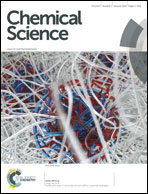Inaccessibility of the μ-hydride species in [FeFe] hydrogenases†
Abstract
[FeFe] hydrogenases catalyse the reversible formation and oxidation of H2. They presumably feature a hydride species as a key intermediate. The H− ligand can either be bound between the iron atoms of the [2Fe]H subsite (μ-H) or terminally to the distal iron atom of the active site (terminal-H). Although the μ-H species is thermodynamically most stable, experimental evidence points to the terminal-H species as the relevant intermediate. In order to understand these contradictory results, we investigate the catalytic cycle of [FeFe] hydrogenases (including transition states) with a special focus on the role of the two possible hydride intermediates. For this, density functional theory calculations were carried out for a large quantum mechanical active-site model. It is shown that formation of the μ-H intermediate is prohibited by high activation barriers which are caused by interactions of the H cluster with surrounding amino acids. We provide direct evidence for the anchoring of the H cluster in the protein to be decisive for the kinetic hindrance of μ-H formation.
![Graphical abstract: Inaccessibility of the μ-hydride species in [FeFe] hydrogenases](/en/Image/Get?imageInfo.ImageType=GA&imageInfo.ImageIdentifier.ManuscriptID=C3SC51700D&imageInfo.ImageIdentifier.Year=2014)

 Please wait while we load your content...
Please wait while we load your content...